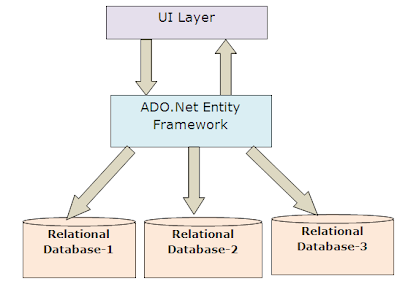ADO.NET Entity Framework
The ADO.NET Entity Framework is Microsoft’s new approach
to develop applications which will refer to the Entity data model instead of
the conventional approach of referring to the Relational data model.
In the conventional approach
we connect to the databases (SQL Server, Oracle, DB2 etc) using database
specific connection strings and use relational queries (INSERT, UPDATE, DELETE,
SELECT etc) to manipulate data from the databases.
In the new ADO.NET Entity Framework, we need not perform
queries against the databases; instead we can query the Entity model and retrieve the data. Here the developers will not access the actual Relational data model, instead they will query against an abstracted Entity model.
The advantage of using the Entity Framework, is that we can switch between multiple relational databases using the same code, under the hood the Entity Framework takes care of the mapping to the different types of relational database.
The Entity Framework can be look upon as the next version of LINQ to SQL, LINQ to SQL is similar to the Entry Framework, but has limited features and is viewed as a Rapid Application Development tool. To know more about LINQ to SQL refer the post .
The advantage of using the Entity Framework, is that we can switch between multiple relational databases using the same code, under the hood the Entity Framework takes care of the mapping to the different types of relational database.
The Entity Framework can be look upon as the next version of LINQ to SQL, LINQ to SQL is similar to the Entry Framework, but has limited features and is viewed as a Rapid Application Development tool. To know more about LINQ to SQL refer the post .
Related Post
Concepts
ADO.NET Entity Framework
ADO.NET Entity Framework Architecture
Entity Data Model
LINQ To SQL Vs ADO.Net Entity Framework
Programming
ADO.Net Entity Data Model Prerequisite
Creating your First ADO.Net Entity Data Model
Selecting Data using ADO.Net Entity Framework
Selecting Data by Joining Tables using ADO.Net Entity Framework
Inserting Data using ADO.Net Entity Framework
Inserting Data with Foreign Key Reference using ADO.Net Entity Framework
Updating Data using ADO.Net Entity Framework
Updating Data with Foreign Key Reference using ADO.Net Entity Framework
Deleting Data using ADO.Net Entity Framework
Concepts
ADO.NET Entity Framework
ADO.NET Entity Framework Architecture
Entity Data Model
LINQ To SQL Vs ADO.Net Entity Framework
Programming
ADO.Net Entity Data Model Prerequisite
Creating your First ADO.Net Entity Data Model
Selecting Data using ADO.Net Entity Framework
Selecting Data by Joining Tables using ADO.Net Entity Framework
Inserting Data using ADO.Net Entity Framework
Inserting Data with Foreign Key Reference using ADO.Net Entity Framework
Updating Data using ADO.Net Entity Framework
Updating Data with Foreign Key Reference using ADO.Net Entity Framework
Deleting Data using ADO.Net Entity Framework



No comments:
Post a Comment